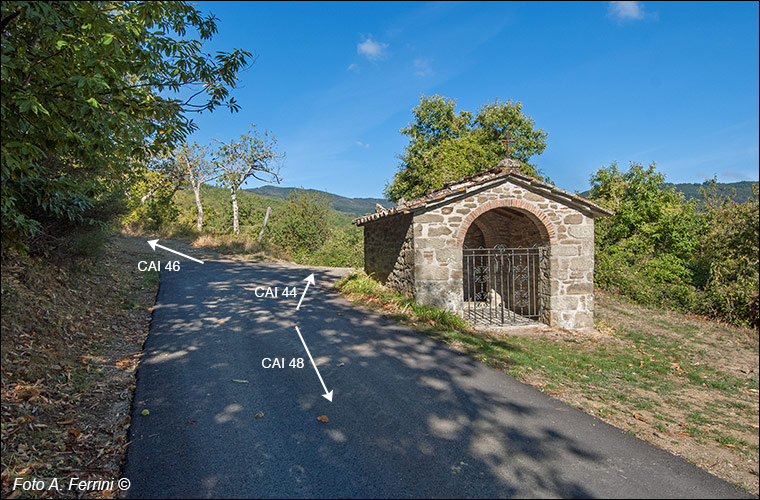Con Guido Monaco all'Abbazia di Santa Trinita
itinerario da Pontenano all'abbazia benedettina di Santa Trinita e al Varco di Anciolina
Italiano
STRADE E LUOGHI STORICI SUL PRATOMAGNO 10
Dopo duecento metri giungiamo a questa maestà. Qui il CAI 48 termina e iniziano i percorsi CAI 46 e 44. Il primo, a sinistra, sale verso il Varco di Anciolina, lo faremo al ritorno. Ora andiamo a destra sul CAI 44 che in circa cinque chilometri ci conduce a Badia Santa Trinita.
Stiamo entrando in una zona che per secoli è stata sinonimo di ricchezza, il territorio del Comune di Talla dove si trovavano le selve di castagno più produttive in termini di legna da ardere, carbone, legname da opera, castagne. Non solo, boschi che permettevano l'allevamento di tanti maiali. A tal proposito è opportuno ricordare che dal medioevo fino all'Ottocento, parametro fondamentale per stimare il valore di un bosco era quanti maiali poteva nutrire. In una zona così importante dal punto di vista economico, ogni giorno vi accedevano per lavoro tante persone. Questo è il motivo che sull'incrocio a fine CAI 48 si trova una maestà. Era buona abitudine dire una preghiera prima di recarsi al lavoro e una al ritorno. Questi edifici religiosi, più o meno grandi, sono molto diffusi sul Pratomagno. Furono costruiti per lo più nella seconda metà dell'ottocento.
After two hundred meters we reach this religious building. Here CAI 48 ends and CAI routes 46 and 44 begin. The first, on the left, goes up towards the Anciolina pass, which we will follow on the return. Now we go right onto CAI 44 which in about five kilometers leads us to Badia Santa Trinita.
We are entering an area that for centuries has been synonymous with wealth, the territory of the Municipality of Talla where the most productive chestnut forests in terms of firewood, coal, timber and chestnuts were located. Not only that, woods that allowed the breeding of many pigs. In this regard, it is worth remembering that from the Middle Ages until the nineteenth century, a fundamental parameter for estimating the value of a forest was how many pigs it could feed. In such an important area from an economic point of view, many people entered it for work every day. This is the reason why there is a majesty at the intersection at the end of CAI 48. It was a good habit to say a prayer before going to work and one on the way back. These religious buildings, more or less large, are very widespread in Pratomagno. They were mostly built in the second half of the nineteenth century.













































































